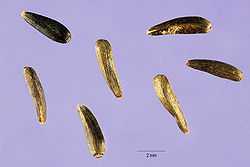Niger seed oil

Niger seed oil is obtained from the seeds of Niger plant, which belongs to the Asteraceae family and of the Guizotia genus. The botanical name of the plant is Guizotia abyssinica. The Niger plant is an erect, stout, branched annual herb, grown for its edible seeds and oil. Cultivation for the plant originated in the Ethiopian highlands, and has since spread from Malawi to India.[1]
Common and local names
Common names in English include niger, nyger, or nyjer. The local names for the plant in the regions that it is grown include: noog or nūg (Ethio-Semitic); ramtil or ramtilla (Hindi,karale (कारळे) /Khurasni(खुरसणी) Marathi, Punjabi); sorguja, surgia, or sorguza (Assamese, Bengali); verrinuvvulu, or valisalu (Telugu); huchellu, or karelle (Kannada); payellu (Tamil).[2]
Cultivation
Niger seed is a minor oil seed crop cultivated in Ethiopia, India, Germany, West Indies, Brazil, Mexico, China, Nepal, and Myanmar. Requiring moderate rainfall between 1000–1250 mm annually, it needs moist soil to grow properly. Niger should be grown in light black soils or brownish loam with sufficient depth but it can be also be grown on well drained heavy soils or rocky laterite soils. It can grow in semi-shade or without shade. The yield of seeds will average 300–400 kg/hectare under favorable conditions but can produce up to 600 kg/hectare. It gives a dependable yield even under unfavorable climatic conditions.[2]
Seeds
Niger seed resembles sunflower seeds in shape, but is smaller in size and black. It bears a fairly thick, adherent seed coat and can be stored for up to a year without deterioration. Niger seed contains proteins, oil and soluble sugars. Niger seeds are used as bird feed world wide. Commercial niger seed is grown in Africa, India and other areas of southeast Asia, and the seed is imported around the world as a popular type of birdseed. Before it is imported, however, niger seed is sterilized by intense heat to prevent germination of any additional seeds that may be part of the mix. Treated niger seed may germinate but would typically be stunted, limiting its spread and offering less of a threat to native plants.[3]
Basic Nutritional Components of Niger Seeds
| Component | Percentage |
| Oil | 30% - 40% |
| Proteins | 10% - 25% |
| Soluble Sugars | 12% - 18% |
| Crude Fiber | 10% - 20% |
| Moisture | 10% - 11% |
Niger seed Oil
Niger seed yields about 30-35% of its weight in oil which is clear, slow-drying, and edible. Niger seed oil is polyunsaturated semi-drying oil. It has pale yellow or orange color with a nutty taste and sweet odor. Raw oil has low acidity and can be used directly for cooking. Normally it has a poor shelf life and will become rancid when stored for a long period. Its fatty acid composition is similar to sunflower oil and has high content of linoleic acid. It is used substitute for olive oil and can be mixed with linseed oil. The presence of linoleic acid varies from 45.0-65.0% depending on harvested soil conditions and seed variety. The physical character of oil and its fatty acids composition is furnished following tables.[4]
Physical Characteristics of Oil[5]
| Characteristic | Range |
| Refractive Index400C | 1.4655 - 1.4673 |
| Saponification Value | 187 - 195 |
| Iodine Value | 112 - 129.0 |
| Unsaponifiable Matter | 0.5 - 1.0% |
| Moisture | 0.5 - 0.75% |
| Bellier Turbidity Temperature | 24.5 - 27.8 °C |
| F.F.A | 0.2 - 2.0% |
Fatty acid composition of Niger seed oil[5]
| Fatty Acid | Percentage |
| Myristic acid(C14:0) | 1.7%-3.4% |
| Palmitic acid(C16:0) | 5.8%-13.0% |
| Stearic acid(C18:0) | 5.0%-7.5% |
| Oleic acid(C18:1) | 13.4%-39.3% |
| Linoleic acid(C18:2) | 45.5%-65.8% |
Uses
- Ethiopians use the Niger seed for the oil extraction for human consumption as cooking oil.[6]
- Ethiopians use a semi solid paste made from Niger seed and honey to eat snacks ( such as kollo- which is made from barley) with.
- It is widely used for industrial purposes such as soap making, paints preparations and preparation of different types of emulsions.[7]
- "Edible oil which is slow-drying, used in foods, paints, and soaps, and as an illuminant. It is used as a substitute for olive oil, can be mixed with linseed oil, and is used as an adulterant for rapeseed oil, sesame oil, et al."[4]
- used for cattle feeds
References
- ↑ Nigerseed: Specialty Grain Opportunity for Midwestern US
- ↑ 2.0 2.1 SEA Hand Book-2009 by Solvent Extractors' Association Of India
- ↑ Nyjer, Niger or Thistle - What Is Nyjer Seed
- ↑ 4.0 4.1 Purdue University - Guizotia abyssinica
- ↑ 5.0 5.1 Studies on niger (Guizotia abyssinica) seed oil. - Abstract
- ↑ http://www.epospeaeth.org/index.php/products/oil-seeds/niger-seed
- ↑ welcome to THE DML Group | Exporters of Indian Cotton, Spices, Pulses, Grains & Oil Seeds